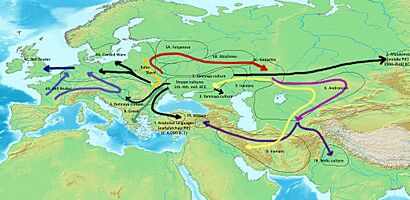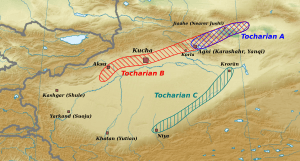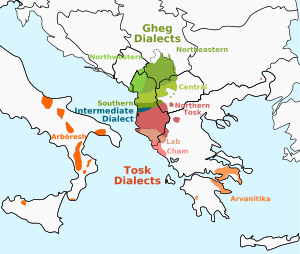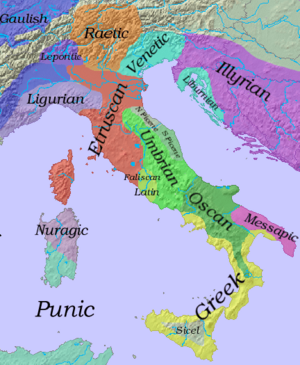List of Indo-European languages facts for kids
The Indo-European language family is a huge group of languages. It includes a very large number of individual languages, together spoken by roughly half the world's population.
Contents
How Many Indo-European Languages Are There?
The Indo-European family has about 449 languages that are still spoken today. These languages are used by around 3.5 billion people. That's roughly half of everyone on Earth! Most of the major languages in Europe, Western Asia, and Southern Asia belong to this family.
It's the biggest language family in the world based on how many people speak them as their native language. However, it's not the biggest by the total number of languages. Eight out of the top ten languages with the most native speakers are Indo-European. One of these, English, is like a global "common language" (a lingua franca). More than a billion people speak English as a second language.
The Indo-European language family has 10 main groups, called branches or subfamilies. Eight of these branches are still alive today, but two are extinct. Scientists are still learning how these branches are related to each other. Some Indo-European languages are not yet sorted into a specific branch.
If we include all the known extinct Indo-European languages, the total number is more than 800, possibly even close to a thousand! This list includes all known Indo-European languages, both living and extinct.
The Ancient Roots of Indo-European Languages
The people who spoke the very first Indo-European language, called Proto-Indo-European, lived around 4500 BCE (about 6,500 years ago). Over time, starting around 4000 BCE, these people began to spread out. They moved to new areas and influenced other cultures. This led to many changes in languages across Western and Southern Eurasia. This is how the many languages and branches of this family began.
By 1000 BCE, millions of people spoke Indo-European languages. They lived in a huge area covering most of Western and Southern Eurasia. This included parts of Western Central Asia.
Over the next 2,000 years, even more people started speaking Indo-European languages. However, some areas, like parts of Central Asia and Asia Minor, began to speak other language families, mostly Turkic languages. This happened because of Turkic groups expanding and settling in those areas. Hungary also started speaking a non-Indo-European language (Hungarian) after Magyar people settled there.
But after 1500 AD, Indo-European languages spread even more. They reached North Asia (Siberia) as Russia expanded. They also spread to North America, South America, Australia, and New Zealand. This was due to European explorers and conquerors from countries like Portugal, Spain, France, England, and the Netherlands. These countries had large empires.
When different peoples and languages met, especially during European colonization, new languages formed. These included pidgins, creoles, and mixed languages. Many of these new languages are based on Indo-European languages. They are often found on islands and in coastal areas.
Understanding Proto-Indo-European Language
The very first language in this family is called Proto-Indo-European. It is now extinct. It's like the great-great-grandparent of all Indo-European languages.
- Proto-Indo-European (extinct)
- Early Proto-Indo-European (the first version of Indo-European)
- Middle Proto-Indo-European (the "classic" Indo-European)
- Late Proto-Indo-European (the last version spoken before it split into many different languages. These new languages came from regional dialects that changed over time and spread out. They became the direct ancestors of today's language branches.)
- Middle Proto-Indo-European (the "classic" Indo-European)
- Early Proto-Indo-European (the first version of Indo-European)
When Did Language Branches Split Off?

All Indo-European languages come from a common ancestor, Proto-Indo-European. But the different branches (large groups of related languages) didn't all split off at the same time. How they are related to each other is still a topic scientists are studying.
However, many experts agree that the Anatolian languages were the first group to split off. The Tocharian languages were the second.
Here's one idea about when the branches split, from researchers Donald Ringe and Tandy Warnow:
- Proto-Indo-European (PIE)
- Pre-Anatolian (before 3500 BC)
- Pre-Tocharian
- Pre-Italic and Pre-Celtic (before 2500 BC)
- Pre-Armenian and Pre-Greek (after 2500 BC)
- Proto-Indo-Iranian (2000 BC)
- Pre-Germanic and Pre-Balto-Slavic; proto-Germanic (500 BC)
Another idea, from David W. Anthony, suggests a slightly different order:
- Proto-Indo-European (PIE)
- Pre-Anatolian (4200 BC)
- Pre-Tocharian (3700 BC)
- Pre-Germanic (3300 BC)
- Pre-Italic and Pre-Celtic (3000 BC)
- Pre-Armenian (2800 BC)
- Pre-Balto-Slavic (2800 BC)
- Pre-Greek (2500 BC)
- Proto-Indo-Iranian (2200 BC); split between Old Iranian and Old Indic 1800 BC
Protolanguages: The Ancestors of Indo-European Branches

– Centre (5th.-4th. mill. BCE - Proto-Indo-European): Steppe cultures (West Eurasian Steppe, Pontic–Caspian steppe)
1 (black): Anatolian languages (early / archaic PIE)
2 (black): Afanasievo culture (ancestral to Tocharians and Tocharian languages) (middle PIE)
3 (black): Yamnaya culture expansion (Pontic–Caspian steppe, Danube Valley) (late PIE) (southwest black line): Proto-Italic, Proto-Celtic and other possible Indo-European branches
4A (black): Western Corded Ware
[NN] (black): pre-Proto-Germanic
[NN] (dark yellow): proto-Balto-Slavic (Balto-Slavic languages of the Baltic and Slavic peoples)
4B-C (blue & dark blue): Bell Beaker; adopted by Indo-European speakers
5A-B (Fatyanova-Abashevo) (red): Eastern Corded ware
5C (red): Sintashta (proto-Indo-Iranian)
6 (magenta): Andronovo
7A (purple): Indo-Aryans (Mittani)
7B (purple): Indo-Aryans (Āryāvarta, modern northern India and Pakistan, later expanding towards Sri Lanka and the Maldives)
8 (grey): proto-Greek
9 (yellow): proto-Iranian (Iranian languages of the Iranian peoples)
– [not drawn]: Armenian, expanding from western steppe and settling in the Armenian Highlands by a western or an eastern route. Geographical group of languages known as Paleo-Balkan in the Balkans, included Dacian, Moesian, Thracian, Brygian (Balkan Phrygian), Paeonian, Illyrian, and Dalmato-Pannonian.
Here is a list of the ancient "proto-languages" that developed into the Indo-European language family. These are like the direct parents of today's language branches.
- Pre-Proto-Indo-European
- Proto-Indo-European
- Early / Archaic PIE
- Proto-Anatolian
- Early / Archaic PIE
- Proto-Indo-European
*Proto-Luwian *Proto-Lydian *Proto-Palaic *Proto-Hittite
-
-
-
- Middle PIE
-
-
*Proto-Tocharian *Late PIE **Illyrian†? ***Proto-Albanian ***Messapic†? '**'(PIE 4) ***Italo-Celtic ****Proto-Italic *****Proto-Latino-Faliscan *****Proto-Osco-Umbrian ****Proto-Celtic *****Proto-Continental-Celtic ******Proto-Eastern-Celtic ******Proto-Gaulish ******Proto Hispano-Celtic *******Proto-Celtiberian *******Proto-Gallaecian *****Proto-Insular-Celtic ******Proto-Brittonic ******Proto-Goidelic ****Ligurian†? ****Lusitanian†? '***'(PIE 5) ****Graeco-Phrygian? *****Proto-Greek *****Armeno-Phrygian? ******Proto-Phrygian ******Proto-Armenian '****'(PIE 6) *****Germanic parent language (pre-Proto-Germanic) ******Proto-Germanic *******Proto-Northwest-Germanic ********Proto-Norse ********Proto-West-Germanic *******Proto-East-Germanic *****Proto-Balto-Slavic ******Proto-Baltic *******Proto-Western-Baltic *******Proto-Eastern-Baltic ******Proto-Slavic *******Proto-East-Slavic ********Proto-Ruthenian-Russian *********Proto-Ruthenian *********Proto-Russian ********Proto-Novgorodian-Pskovian *******Proto-West-South Slavic ********Proto-West-Slavic *********Proto-Lechtic *********Proto-Sorbian *********Proto-Czech-Slovak ********Proto-South-Slavic *********Proto-Western South Slavic **********Proto-Slovene **********Proto-Shtokavian *********Proto-Eastern South Slavic **********Old-Slavonic *****Daco-Thracian? *****Proto-Indo-Iranian ******Proto-Iranian *******Proto-Eastern-Iranian ********Proto-Northeast-Iranian *********Proto-Scythian ********Proto-Southeast-Iranian *********Proto-Sogdo-Bactrian *******Proto-Western-Iranian ********Proto-Northwest-Iranian ********Proto-Southwest-Iranian ******Proto-Nuristani ******Proto-Indo-Aryan *******Old Indo-Aryan ********Vedic Sanskrit *********Sanskrit **********Proto-Middle Indo-Aryan (Prakrit) ***********Gandhari ***********Proto-Pahari ***********Pali ***********Ashokan Prakrit ************Proto-Shauraseni *************Proto-Sindhi *************Proto-Punjabi *************Proto-Western-Hindi ************Ardhamagadhi *************Proto-Magadhi **************Proto-Bihari **************Proto-Bengali-Assamese **************Proto-Kamata **************Proto-Odia ************Proto-Maharashtri *************Proto-Marathi-Konkani *************Proto-Sinhalese-Maldivian
Anatolian Languages (All Extinct)
These languages were spoken in ancient Anatolia (modern-day Turkey). They are all extinct now.
- Proto-Anatolian
- Hittite
- Hittite
- Luwic
- Luwian
- Aštanuwa Luwian
- Kizzuwadna / Kizzuwatna Luwian
- Luwian
- Hittite
-
-
-
- Empire Luwian
-
-
*Iron Age Luwian
-
-
-
- Cataonian
- Isaurian
- Lycaonian
- Southwest
-
-
*Carian *Lycian *Milyan *Pisido-Sidetian **Pisidian **Sidetic
-
- Western Anatolian?
- Lydian
- Palaic
- Palaic
- Unclassified
- Kalasmian
- Western Anatolian?
Tocharian Languages (All Extinct)
These languages were spoken in Central Asia, in the Tarim Basin. They are also all extinct.
- Proto-Agni-Kuči
- North-Tocharian
- Agnean (Tocharian A)
- Kuchean (Tocharian B)
- South Tocharian
- Kroränian (Tocharian C) (possible)
- North-Tocharian
Albanian Language
The Albanian language is spoken mainly in Albania and Kosovo. It has several dialects.
- Proto-Albanian (extinct)
- Middle Albanian (extinct)
- Albanian (Modern Albanian)
- Gheg Albanian
- Albanian (Modern Albanian)
- Middle Albanian (extinct)
*Northern Gheg **Arbanasi **Northeastern Gheg *Southern Gheg **Upper Reka
-
-
-
- Transitional Gheg-Tosk Albanian
- Tosk Albanian
-
-
*Northern Tosk *Lab *Cham '**'Arbëresh '**'Arvanitika
Italic Languages
The Italic languages include Latin, which is the ancestor of all Romance languages.
- Proto-Italic (extinct)
- Osco-Umbrian languages (all extinct)
- Umbrian
- Umbrian
- Sabine
- Hernican
- Marsian
- South Picene
- Volscian
- Oscan
- Oscan
- Marrucinian
- Paelignian
- Sidicinian
- Pre-Samnite
- Umbrian
- Latino-Faliscan languages
- Faliscan (extinct)
- Latin (extinct as first language)
- Old Latin (extinct)
- Osco-Umbrian languages (all extinct)
*Classical Latin (extinct) **Latium Latin ***Roman Latin ****Rural Roman Latin ****Urban Roman Latin *****Standard Latin *****Vulgar Latin **Provincial Latin ***Northern Latin ****Western Latin *****Italic-Latin *****Gallo-Hispanic Latin ******Gallic Latin *******Cisalpine Gallic *******Transalpine/Gallic and Aquitanian Latin ********British Latin / Britannic Latin *******Rhaetian Latin ******Hispanic Latin ****Eastern Latin *****Illyrian Latin ******Pannonian Latin ******Dacian Latin ******Thracian Latin *****Greco-Latin ***Southern Latin ****Insular Latin *****Corsican Latin *****Sardinian Latin ****African Latin **Late Latin ***Ecclesiastical Latin ***Medieval Latin ****Broad Medieval Latin *****Hiberno-Latin / Hisperic Latin *****Renaissance Latin ******Neo-Latin or New Latin *******Contemporary Latin ***Late Vulgar Latin (extinct) ****Romance *****Continental Romance ******Italo-Western languages *******Italo-Dalmatian languages ********Italian *********Old Italian (extinct) '**********'Central Italian ***********Latian ************Romanesco ***********Sabino ***********Umbrian (Romance Umbrian) ***********Central Marchigiano **********Southern Italian '***********'Southern Italian Proper / Neapolitan ************Southern Laziale ************Abruzzese and Southern Marchigiano ************Molisan ************Campanian ************Apulian ************Lucanian / Basilicatan - Northern Calabrian '***********'Extreme Southern Italian ************Southern Calabrian ************Sicilian ************Cilentano Meridionale ************Salentino **********Old Tuscan '***********'Tuscan ************Northern Tuscan *************Florentine '**************'Italian / Standard Italian *************Lucchese *************Versiliese *************Viareggino *************Pisano-Livornese ************Southern Tuscan *************Aretino-Chianaiolo *************Grossetano *************Elbano '***********'Corsican ************Northern Corsican ************Southern Corsican ************Corsican-Sardinian '*************'Gallurese '*************'Sassarese '**********'Venetian ***********Central Venetian ***********Sea Venetian ***********Western Venetian ***********Northern Venetian ***********Northern Venetian diaspora dialects '**********'Judeo-Italian / Italkian *******Western Romance languages ********Gallo-Hispanic/Gallo-Iberian *********Gallo-Romance languages **********Gallo-Italic '***********'Emilian-Romagnol ************Romagnol ************Emilian ***********Transitional Emilian-Lombard '************'Lombard-Emilian '***********'Lombard ************Eastern Lombard ************Western Lombard '*************'Spasell (extinct) ***********Transitional Lombard-Piemontese '************'Novarese '***********'Piedmontese ************Eastern Piemontese ************Western Piemontese '***********'Ligurian ************Eastern Ligurian ************Genoese Ligurian ************Oltregiogo Ligurian ************Intemelian-Alpine Ligurian *************Intemelio **************Monégasque *************Alpine Ligurian **************Brigasc **************Royasc '***********'Gallo-Italic of Basilicata '***********'Gallo-Italic of Sicily **********Gallo-Rhaetian ***********Rhaeto-Romance '************'Friulian '************'Ladin '************'Romansh ***********Oïl ************Southeast Oïl '*************'Arpitan '**************'Faetar-Cellese ************Old French (extinct) *************Middle French **************Burgundian '***************'Burgundian-Morvandeau ***************Frainc-Comtois/Jurassien **************Central Oïl ***************North Central Oïl ****************Francien / Francilien '*****************'French ******************European French *******************French of France ********************Île de France French *********************Parisian **********************Standard French *******************Belgian French *******************Swiss French *******************Aostan French *******************Jersey Legal French ******************American French *******************Canadian French ********************Acadian French *********************Chiac '*********************'Louisiana French (Cajun French) ********************Québec French *********************"Old" dialects *********************"New" dialects *********************Expatriate dialects **********************New England French **********************Manitoba French *********************Missouri French (nearly extinct) *******************Newfoundland French (nearly extinct) *******************Frenchville French (nearly extinct) ******************Saint-Barthélemy French ******************Caribbean French *******************Haitian French *******************West Indian French ******************Guianese French ******************Oceania French *******************New Caledonian French ******************African French ******************Maghreb French ******************Indian French ******************South East Asian French ****************Loire North Central Langue d'Oil *****************Orleanais *****************Blésois *****************Tourangeau ***************South Central Oïl '****************'Berrichon '****************'Oïl Bourbonnais **************East Oïl '***************'Champenois '***************'Lorrain **************Armorican (Western Oïl) '***************'Manceau '***************'Mayennais '***************'South Norman '***************'Angevin '***************'Gallo **************Frankish (Northern Oïl) ***************Northwest Oïl ****************Old Norman '*****************'Norman ******************Continental/Mainland dialects *******************Cauchois *******************Augeron *******************Cotentinais ******************Norman Islands / Channel Island dialects *******************Auregnais (extinct) *******************Guernésiais *******************Jèrriais ********************Sercquiais (nearly extinct) ******************Anglo-Norman (extinct) ***************North Oïl Proper '****************'Picard *****************Amiénois *****************Vimeu-Ponthieu *****************Vermandois *****************Thiérache *****************Beauvaisis *****************"Chtimi" *****************Lille *****************"Rouchi" *****************Borain *****************Artésien Rural *****************Boulonnais '****************'Walloon *****************Western Waloon *****************Central Waloon *****************Eastern Waloon *****************Southern Waloon **************Southwest Oïl '***************'Poitevin-Saintongeais ****************Poitevin ****************Saintongeais **************Zarphatic (Judaeo-French) (extinct) ***********Moselle Romance (extinct) ********Occitan-Hispanic **********Occitan ***********Old Occitan (extinct) '************'Occitan *************Arverno-Mediterranean **************Eastern ***************Provençal ****************Niçard ****************Maritime ****************Rhodanien *****************Shuadit (extinct) ***************Vivaro-Alpine ****************Eastern *****************Alpine ******************Cisalpine ******************Gavot ****************Guardiol ****************Western ***************** Vivaro-Dauphinois **************Western ***************Auvergnat ****************Southern Auvergnat ****************Northern Auvergnat *****************Croissant Auvergnat ***************Limousin ****************Croissant Limousin *************Central Occitan **************Lengadocian ***********Aquitano-Pyrenean '************'Gascon *************Lowland Gascon **************East
See also
 In Spanish: Anexo:Lenguas indoeuropeas para niños
In Spanish: Anexo:Lenguas indoeuropeas para niños






